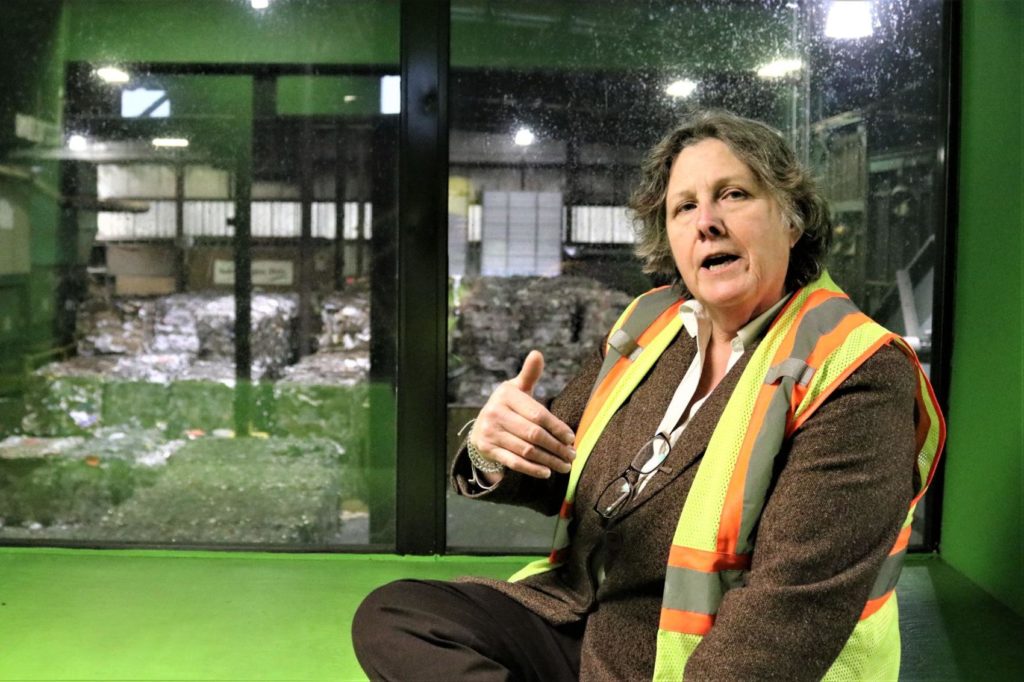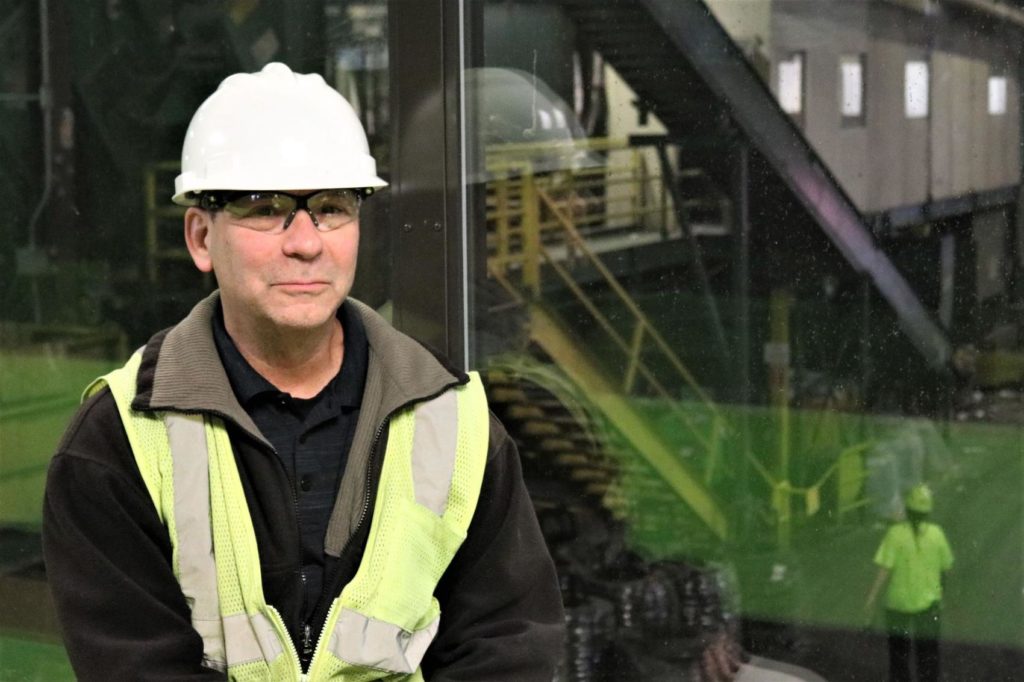
WOODBINE – Picture waking up in the morning. Imagine receiving a trash bag, into which one would put every piece of trash they produce that day.
The breakfast yogurt container goes in, along with the carton of half and half that was finished with their coffee. The morning paper, lunch wrapper, cardboard box from an online delivery, everything goes in the bag. By the end of the day, one would have collected close to 4.5 pounds of trash.
That’s based on a 2013 figure for the average American, compiled by the federal Environmental Protection Agency (EPA). Of that, a little over a pound and a half, on average, gets recycled or composted.
Now, imagine having to hold onto that remaining three pounds, maybe stacking it next to the bed each evening or finding space for it in the closet. Wherever one lives, it’s going to get crowded quickly. The same EPA report said Americans generated 254 million tons of trash, and either recycled or composted about 87 million tons more.
In Cape May County towns, weekly collection is available for trash and recycling, whether by contract, or as part of the services funded by property taxes. Materials need to get to the right bin, but after that, a crew piles it into a compactor truck and it becomes someone else’s problem.
Much of it will be added to the landfill, on Route 610, straddling the border between Upper Township and Woodbine. The landfill is the tallest point in Cape May County, with truckloads more refuse arriving all the time. A living snowcap of seagulls stands at the top through the day, wheeling and squawking, as they are kicked up by the latest arriving batch of trash.
Near the foot of that manmade hillside is a small, white building, in which the mixed recyclable materials get separated and sorted. Each plastic bottle and Sunday circular that ends up baled and sold means more space remaining in the nearby landfill.
International issues have affected Cape May County’s discarded material, and it is getting tougher to find a market for much of what the area recycles. In 2010, Cape May County could get $285 for a ton of recyclable cardboard. That may not sound like much.
Today, it’s $25 a ton, far less than the cost of shipping, much less than the cost of separating the material.
“Prices have just plummeted for us,” said John Conturo, Cape May County Municipal Utilities Authority’s (CMCMUA) solid waste program manager. “We, in the past, were able to subsidize the operational cost of this facility by selling the material. We don’t do that anymore. We operate at a loss.”

The tipping fees, paid to deposit material in the landfill, now underwrite the recycling operation. Years ago, the program brought in enough to give regular rebates to municipalities.
Doors Have Closed
For years, most of what Cape May County and America recycled was shipped to China, some of it filling container ships full of manufactured goods for the return trip across the ocean.
At one time, the Chinese economy sought as much material as possible, but a significant amount of the material that arrived from the U.S., and around the world, included too much contamination to be useful.
Much of it ended up in a landfill, more than 7,000 miles away from where it was thrown out. Even staunch advocates of recycling began to question how this made any environmental or economic sense.
Recently, China has sought to improve its environmental record, which included ending the acceptance of American recyclable material as of the beginning of 2018, a move that changed the math on recycling around the world.
“It was the government that said enough was enough,” said Lyn Crumbock, Cape May County’s recycling coordinator, in a recent interview at the recycling center. “There was too much contamination. At that point, approximately 60% of what the U.S. recovered in recyclable materials went to China.”
“China was filling up their landfills with the world’s trash that was coming in with the recycling stream,” added Conturo. That material had a contamination rate of about 5%, he said.
Other countries have followed suit, with India also shutting its markets. Like other recycling programs around the country, Cape May County’s has felt the impact.
The CMCMUA, and other programs like it, may be able to sell material to firms in Thailand or Vietnam, Crumbock said, but they do not have anything close to the infrastructure that China does.
“They may take one load one month, then there’s like a three-month hiatus until they can accept more,” she said.
“Because of the deluge of materials heading into these smaller markets now that China’s shutting its doors, everybody’s overwhelmed with the amount of material coming to them,” said Conturo.
There are some facilities in the South, Crumbock said, and some material goes to Canada. She said Chinese companies are now buying idle paper mills in the U.S. for use in paper recycling, a new change in the economics and logistics of recycling.
Down in the Dumps
In the 1920s and 1930s, most trash didn’t go far. Towns had their own dumps, usually on the outskirts. Food scraps, mostly, some empty cans and other items got thrown in a pile.
In Ocean City, the area that was once the dump is now the municipal airport and golf course, while Wildwood is working on plans to develop its former dump on the waterfront.
In 1980, Cape May County put the CMCMUA in charge of implementing the county’s solid waste management plan. The authority was created about a decade earlier to design, build and maintain a system for dealing with the county’s sewage. Now, it is in charge of its trash as well.
The authority built the landfill, a transfer station, in Burleigh, and launched a recycling program. In 2013, the county went with single-stream recycling, building the system that now separates the paper from the steel, the glass from the aluminum and the numerous varieties of plastics.
According to Conturo, while some sanitary landfills are running out of room, Cape May County’s has plenty of space for the foreseeable future. He said at the current rate, the estimated life of the landfill is more than 100 years, in part because the county’s population started to decline soon after it was designed, reducing the pressure.
Most of the material rolls into the landfill in the summer, when the county population peaks. A significant portion of the material is construction debris, Conturo said, fed by demolitions and a building boom on the barrier islands.
Although the material being recycled is not bringing in much money, it still makes sense to keep the program going, according to Crumbock, and not only because it’s New Jersey law or the right thing to do. It also keeps tons of material out of the landfill.
“The most valuable thing in a landfill is space,” she said. “For us to throw recycling into a landfill could take up an enormous amount of what we call airspace, and that airspace is very expensive.”
Power from Waste
In some communities, food waste and other organic materials are collected for industrial-level composting, something Conturo said New Jersey is pushing for throughout the state. In those facilities, items like the compostable plastic cups and utensils, required under recent initiatives in Avalon and Stone Harbor, could break down and eventually be used for topsoil.
Conturo said such a project would cost millions. “It’s very expensive,” he said. “We’ve invested millions of dollars in recycling and the facility here, and you see how the market’s dropped. For us to start a composting facility would be millions of dollars.”
Crumbock said such facilities also draw complaints about the smell.
Still, she welcomes the new ordinances and encourages more communities to consider them, saying the materials would biodegrade in the landfill.
“I applaud the initiative. I really do; however, the intent of compostable materials is that they go to a composting facility. We don’t have one,” she said. “It’s kind of like the cart before the horse, so to speak.”
That process of decomposition has value, in addition to creating more space within the landfill. The methane gas that collects within the landfill is collected and used to create electricity that powers operations throughout the site.
“Anything that’s left over is sold back to the grid,” Conturo said.
That kicked off in April 2007. “It has evolved quite a bit since that time,” Crumbock said.
No Other Option
A lot of communities throughout the nation have ended recycling programs in recent years.
“It didn’t make economic sense. They couldn’t keep the process going,” Conturo said. Cape May County’s operation no longer makes economic sense, either, he added.
“You have to remember, we’re mandated by law,” Crumbock said.
To contact Bill Barlow, email bbarlow@cmcherald.com.
This story was produced in collaboration with the New Jersey Sustainability Reporting Hub project. It was originally reported by Bill Barlow for the Cape May County Herald, and may be re-distributed through the Creative Commons License, with attribution.
